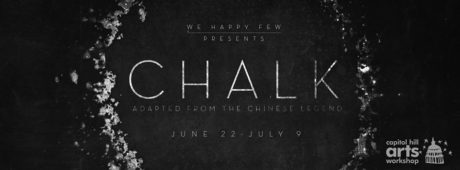There’s an ancient child-custody legend about two women who claim to be the mother of the same infant. In the well-known Hebrew Bible version, their dispute is resolved when King Solomon orders the child to be sliced in half—and the true mother wails, Don’t kill it, let her have it! In the classic Chinese verse play version, a magistrate orders the two wannabe mamas to stand on opposite sides of a chalk circle and pull the child apart. The woman who refuses is again adjudged the true mother.

How, where, and why this don’t-split-the-kid legend originated is kind of a mystery. And the fact it has come down to us in so many theatrical iterations (the Peking Opera, Bertolt Brecht, Charles Mee) is a matter that shrinks and pundits could have a field day with. (What it says alone about patriarchy’s motherlode of mommy and daddy issues is…oh, don’t get me started.) Or maybe the legend lives on onstage for the simple reason that—as amply evidenced in We Happy Few Productions’ antic new adaptation—it plays like blazes.
The show is called Chalk, just opened at the company’s new home at Capital Hill Arts Workshop (CHAW). Actual chalk plays an ingenious part in the production’s fast-paced staging and quick-witted storytelling. You’ve heard of a black box? Chalk turns the theater into a blackboard box. As the audience enters, the flat-black walls are covered with Chalk Designer Adelaide Waldrop’s whimsical drawings of a town square, a clock tower, surrounding mountains, and the like. In the course of the play’s breakneck action, the big blackboard comes amusingly into use as when a royal building is set on fire in an insurrection and an actor scrawls chalk flames on its depiction, or when a renegade is hanged from a hastily etched noose. The flat-black floor too becomes by turns a river outlined in blue from which a woman fleeing with a child drinks, and a bridge of hashtags across which she teeters with the tot to safety. The charming originality of Chalk’s graphical production concept is reason enough to hightail it to the show.
It helps to know going in that Chalk will culminate in a classic chalk-circle scene with a mama-a-mama tug of ward. By the time that contest comes, the suspense is intense, the stakes are high, and the scene does not disappoint. But how the show gets there is a galloping ruckus of delights.
Director (and main writer) Kerry McGee puts Chalk’s cast of seven through some of the zippiest paces this side of movie chases: Josh Adams, Raven Bonniwell, Louis E. Davis, Ann Fraistat, Natasha Gallop, Robert Pike, and Jon Reynold—playing 19 (count ’em) roles—dash on and off and in and out of scenes with head-spinning dexterity. Somehow they find time offstage to change in and out of Costume Designer Julie Leong’s inventive character wear (mostly white, black, and gray like a chalkboard). And Lighting Designer Jason Aufdem-Brinke’s agile light cues and Set Designer Dean Leong’s simple architecture help make the show seem a super-smart cartoon.

So who are these characters, where are they, and what’s going on? It’s someplace vaguely Russian, or so it seems from the costumes and the scene-changing folk melodies chosen by Sound Designer Robert Pike. There’s a governor and his wife who are overthrown in some sort of coup. There’s a serving woman who cares for their baby boy and escapes with it. Multicomplications ensue, which to be honest I’m ill equipped to explain. In the manic mayhem that kicks off the show, it took me a while to figure out that I didn’t have to track the plot exactly to enjoy all the performances and punchlines.
Promo for the show says helpfully
At its simplest, Chalk is a story of motherhood. A wise judge draws a chalk circle on the ground to determine the true mother of a contested child.
However, it’s also a story about revolution and rebellion. It’s about the choices we are forced to make for ourselves, for our families and for the causes we believe in. It’s about the working class and the wealthy, justice and family, duty and survival.

The entire cast is an excellent ensemble but two performances stand out: Josh Adams as the judge (who seems hilariously dippy but knows what he’s up to) and Natasha Gallop the serving woman (who earns our sympathy instantly and never lets it go).
Catch Chalk at CHAW. The whole shebang is a bangup show.
Running Time: About 95 minutes, with no intermission.
Chalk plays through July 9, 2016, at We Happy Few Productions performing at Capitol Hill Arts Workshop – 545 7th Street, SE, in Washington, DC. Tickets are available online.
For a bigger think about Chalk, and insights into how it came into being, I recommend Production Manager and Dramaturg Keith Hock’s recent blog posts.
RATING:





